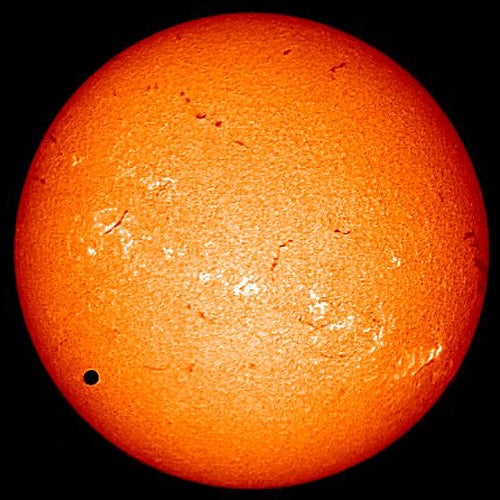For 122 years, every time anyone mentioned a transit of Venus, they always added, “last seen in 1882.” That ended today, June 8, 2004. For the past 3 hours, I — along with my wife and a group of thirty-four intrepid travelers — have watched the disk of Venus slowly move across the face of the Sun. And we still have 3 more hours of the event to observe.
Our group, sponsored by Astronomy magazine and made possible by Mayhugh Travel, arrived at the Entabeni Game Resort in South Africa on Sunday, June 6. This location is 25° south of the equator. For the past 2 days, we’ve been escorted on game drives twice a day (I like to think of them as mini-safaris), and we’ve observed the fabulous southern sky each night. But no game drives were scheduled today. Today is transit day.
This morning, we arose at dawn, about an hour before sunrise. The conditions were good but not perfect. The sky overhead was deep blue, but as you looked farther east, the golden and rosy hues of dawn were hidden by a bank of thick clouds — the first we’ve seen in Africa. Still, at this point, the excitement began to build because we knew the transit would start soon. At sunrise, the Moon was in the western sky, a waning gibbous that would take several more hours to set.
Thirty minutes before first contact — the initial meeting of Venus and the Sun — all equipment was poised and ready: 4-inch and 6-inch apochromatic refractors (manufactured by Tele Vue and Astro-Physics, respectively) had visual solar filters securely mounted to their front lens cells. These telescopes are the cream of the crop; for their size, they’re the best money can buy. But other high-quality equipment was also on hand. Off-axis solar filters were installed on 12-inch and 14-inch Schmidt-Cassegrain telescopes (manufactured by Meade and Celestron, respectively).
Several hydrogen-alpha (H-alpha) telescopes (manufactured by Coronado Technology Group) also were set up. These instruments only allow light of a specific wavelength — H-alpha light — to pass through to the eye. Five previous transits have been observed (in 1639, 1761, 1769, 1874, and 1882), but this was the first to be observed in H-alpha light.
Judging by the repeat visits of our group members, I’d say the view through the Coronado scopes were the most popular, and not just because of Venus. Through an H-alpha filter, prominences are visible along the Sun’s edge, and bright, white solar flares can be seen on its disk. Several of both features were visible throughout the transit.
Visually, Venus resembled a large, perfectly round sunspot. Venus’s diameter was 1/32 (about 3 percent) of the Sun’s, and it was seen easily through the telescopes at all magnifications. Venus also was easy to spot with the naked eye — properly protected through a #14 welder’s glass. The most accessible image was the one projected onto a screen by a small refractor mounted to the 12-inch Meade SCT.
Our group observed, chatted, ate a wonderful breakfast, and observed some more. You might think that an event lasting more than 6 hours would get boring, but this certainly was not the case with this group. Interest remained high throughout — everyone realized they were witnessing an event nobody alive had ever seen.
Dennis Hands, a retired schoolteacher from Greensboro, North Carolina, said the event was more than worth the cost of the trip and the long plane flight (about 22 hours in total). “Just look at the variety of equipment and techniques being used by people. What a diverse group, yet we’re all here because of Venus and the Sun,” Hands remarked.
In summary, everyone involved in the Venus transit trip had a great time. Roy and Bonnie Mayhugh, our travel providers, deserve a special thanks for all the preparation involved before the trip, as well as for their graciousness throughout. (Roy even went so far as to bury the electrical cables that power the telescopes so nobody would trip over them at night.) The weather was perfect, the equipment performed flawlessly, and the event was a perfect example of sublime celestial geometry to all who witnessed it. And — as if we needed anything more — we still have 5 more days to enjoy both Africa and the southern sky.










